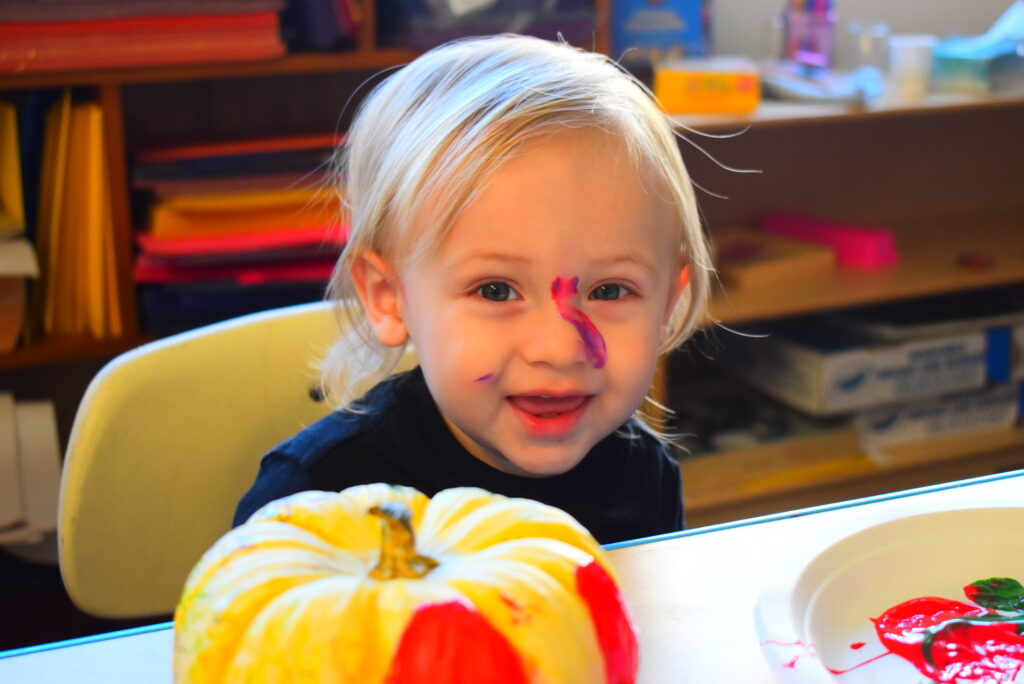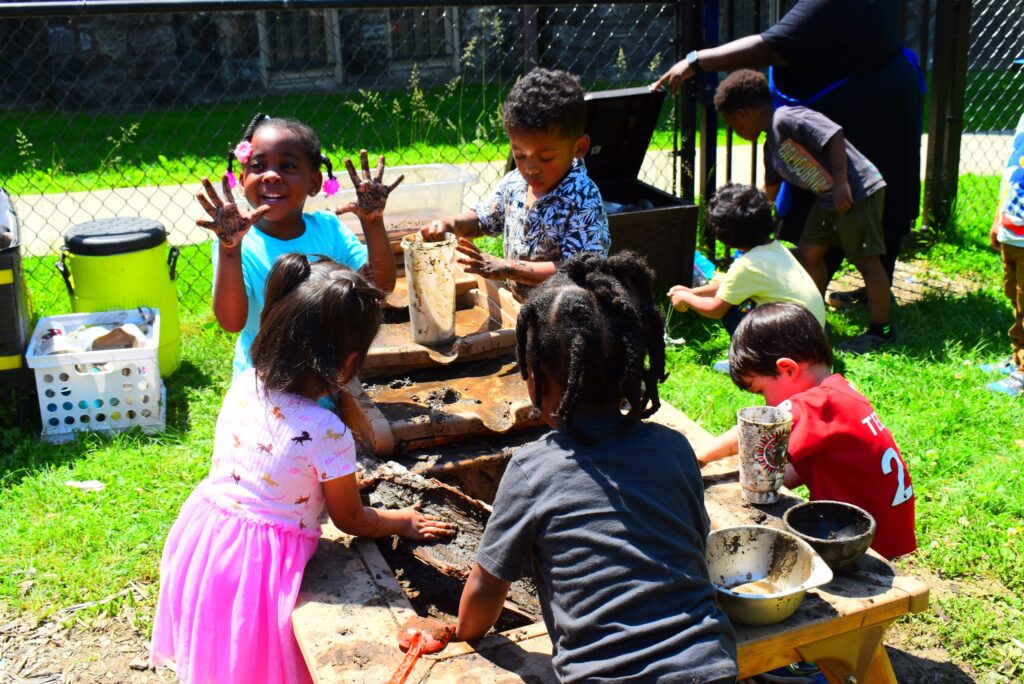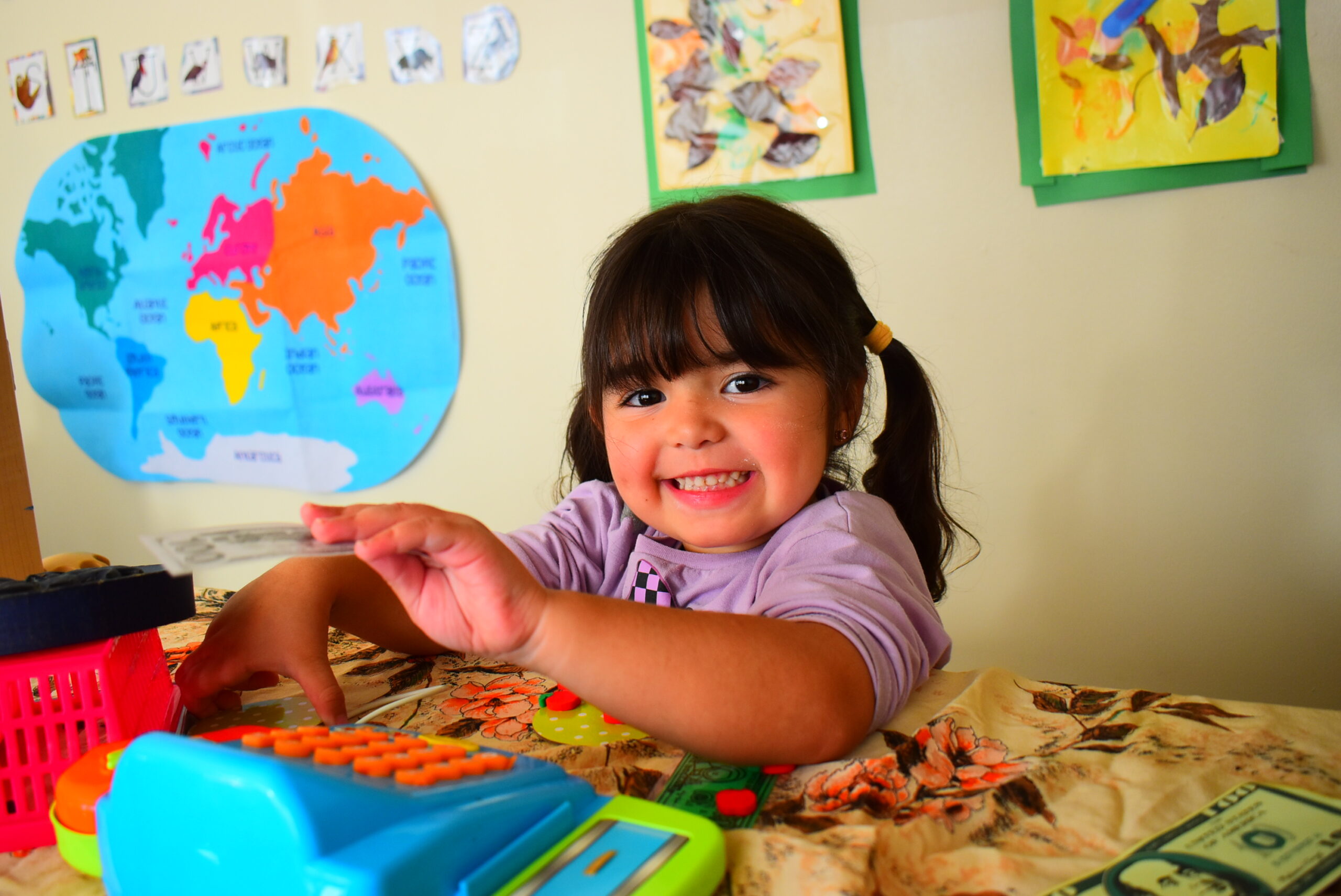Your Child’s Day
Peek inside your child’s classroom where every space says, “Please touch!” In early childhood, the environment and relationships are the curriculum. What’s visible is simple: books and blocks, costumes and props, a rug for gathering; what’s invisible is the training, expertise and planning that connects it all and provides a pathway for each child’s learning. From the first hello to the last goodbye, children learn from every part of their schedule, playtime, interactions with peers, and warm engagement with teachers.
Let’s walk through your child’s day at the DAY ONE Early Learning Center!
Morning Arrival
Long before your child arrives at DAY ONE, the transition from home to school has been in motion. Some children slept well, another may have awakened with a bad dream; some have been up for hours, some just rolled out of bed; some have eaten breakfast, some grabbed a bite on the way out the door. If you are able to drop your child off, it helps to share this information so that your child’s teacher knows what kind of support to offer through the first minutes of the day.
In our Toddler, 3 year old and mixed age classrooms, teachers and parents establish relationships through conversation at drop off and pick up, and also use an app that connects home and school. In our UPK classrooms, where many children arrive on the school bus, teachers use the app to send photos and captions about memorable moments in each child’s day. DAY ONE invites family members to speak with the teachers and/or the director about any concerns they might have about the program or their child’s development.
Children practice routines and separation in morning arrival. Some children separate easily from the first day of school; others keep working on separation for many weeks. Simple, consistent routines work best for most children and family members. A child develops independence through an arrival routine such as: go to your cubby, put away your coat and backpack, give three kisses to Mommy, and share a high five to have a great day! At any age, children often establish favorite “first things” to do after a caregiver leaves, like reading a book with a teacher, waving goodbye from a window, or diving into a messy art project!
Meal Time
Mealtime at our early learning center includes breakfast, lunch and snack. For our younger children, we offer a healthy breakfast and snacks; families provide a packed lunch. The school district provides breakfast and lunch for our Universal Pre-K classrooms. The children work toward independence (pouring one’s own juice, cleaning up one’s place) and simple table manners. Mealtimes also offer practice in sequencing and steps (e.g. wash hands, get cup and napkin, sit down, ask for items to be passed, eat, clean up). Mealtime conversations help children to get to know one another, discover similar interests, and rehearse memories of shared experiences such as morning activity. Children’s observations often spark opportunities for math or science discussions: how many children like broccoli? Why does the pancake soak up the syrup?
Circle Time
Once or twice a day, teachers gather the children for circle time, which often begins with a welcome activity like name games, and counting and letter sound activities. Here, children take turns, practice self-regulation, and share exciting information. Teachers often invite children to engage with a book related to a classroom theme such as animals, seasons, or space. Circle time often provides a plan for the day, including open choice activities.

Open Choice Activities
Open choice activities are the heart of the curriculum for older toddlers and preschoolers. Your child will learn to make choices and become more independent by interacting with varied learning opportunities. Each room contains an area for art, blocks, books, gathering, pretend play, manipulatives, sensory activities, and writing. Here is a quick peek at each area.
- Art Area: Classroom art areas include an easel or a table with art supplies. On any given day, art may also occur on the floor, wall or hallway with large mural paper, cardboard, etc. Art activities are open-ended, offering children opportunities for creative expression. Art is also an early literacy and science activity. Creating meaning on paper is a form of literacy and communication. Colors, light and textures contribute to observation and experimentation, key to science learning.
- Block Area: The block area is rich in learning opportunities. Your child can see and experiment with shape and size, proportions and ratios: how many square blocks does it take to cover one rectangle block? Block building develops math skills, including geometry and fractions, and science skills such as experimentation, trial and error, balance and simple physics. Children communicate through story telling or fantasy play based on their creations. Block construction often includes several children, who need to consider each other’s ideas and perspectives – an important life skill.
- Books and Cozy Area: Books are essential in our classrooms! They are displayed on racks so their covers are visible at eye-level to the child, or in small baskets in a cozy nook. Books are key for developing early literacy skills and promoting language development. In addition, children need quiet spaces where they can go when they need some time to calm down or relax when they are overwhelmed. Children can gain self-regulation skills while interacting with books.
- Manipulatives and Puzzles: Our classrooms contain baskets of toys or objects that children can manipulate or fit together in unique and interesting ways. Common examples are Legos, bristle blocks, and puzzles. This encourages children to think “outside of the box.” Puzzles help children learn about spatial and part-whole relationships. Manipulatives and puzzles strengthen fine motor skills, hand-eye coordination, and problem-solving.
- Dramatic Play Area: Your child’s classroom will have an area for pretend or fantasy play. Teachers choose costumes and props that connect to the learning theme. One week, there may be a space ship and space suits, another, a bakery shop, farmer’s market, or campsite. Creativity abounds as children learn ideas from one another and weave new stories by playing together. Cooperation, communication, perspective-taking and problem-solving are at the heart of pretend play.
- Sensory and Texture Table: Your child’s classroom will have both a sensory table and a larger texture table. Sensory trays may contain playdough, oobleck and putty and tools such as scissors and cookie cutters. Texture tables may hold water, sand, playdirt, or snow and tools for digging, pouring and sifting. Sensory experiences appeal to young children’s rapidly developing sensory systems. Playdough, play sand or putty combine experiences with texture, smell, and color. Children learn about science by observation, or by trying something and seeing what happens. As children pour, dump, and squeeze materials, they observe changes that result from their actions. They learn about weight and volume (math concepts) by manipulating sensory materials. Sensory tables provide for creativity and relaxation or self-calming – important steps in learning how to self-regulate.
- Writing Table: At the writing table, children experiment with different types of writing tools. Younger children use crayons and markers, preschoolers use a variety of tools such as colored pencils and beginner writing pencils. Here children practice fine motor skills and learn that print (including simple marks on paper) have meaning. Making valentines is a good example of a writing activity that is a way to communicate feelings with one another.

Outdoor & Active Movement Play
DAY ONE Early Learning Center has three beautiful outdoor areas for play and exploration: a climbing gym, mud kitchen and giant sandbox. Outdoor play is essential for healthy growth and development. Fresh air and exploration of the natural world fosters curiosity and wonder. Active play outside develops a child’s strength, coordination and ease of movement in different types of spaces. For example, children learn to move their bodies differently in a classroom with furniture and less space than outdoors on grass or climbing structures. We also have a full sized gym for cold or rainy days. Balls, bikes and scooters invite active play, and our giant building blocks foster cooperation and creativity. Active movement each day creates healthy habits and healthy bodies.
Rest Time
If your child is attending our early learning center for a full day, rest time will be part of their day. Although some children complain or resist, we believe that most young children need some downtime in the midst of an active day. Resting our bodies quietly is another way children learn self-regulation skills; resting our brains helps to cement what children have learned in the morning. You may wish to provide your child with a familiar comfort item such as a favorite blanket, pillow or stuffed animal.
Heading Home
The transition from school to home is perhaps the most important one of the day. It completes the circle of trust among parent, child and teacher. A warm good-bye makes for an easier hello and start of the next school day.

